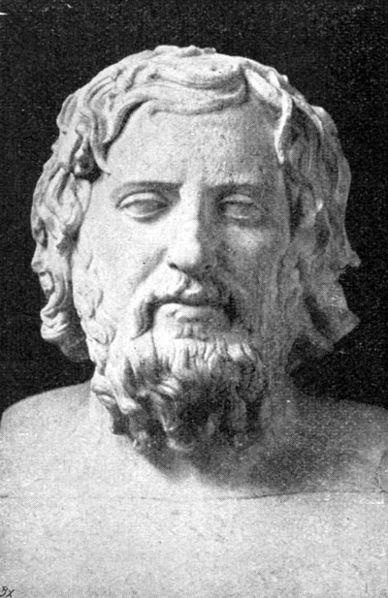 Mull
over and be prepared to write briefly on:
Mull
over and be prepared to write briefly on:In-Class Test Guide
| Homer Test | Xenophon |
| Herodotus Test | |
| Renault & Plato Test |
Study Guide Test 1 – Homer and the Bronze Age
Know the following characters:
Human – Agamemnon (Atreides), Achilles, Calchas, Menelaus, Nestor, Odysseus, Diomedes, Ajax (the Greater, son of Telemon), Chryseis, Briseis, Thersites, Patroclus, Hector, Andromache, Priam, Hecuba, Paris, Helen, Aeneas, Helenus, Cassandra
Divine – Athena/Minerva, Zeus/Jove, Hera/Juno, Apollo, Poseidon/Neptune, Hephaestus/Vulcan, Ares/Mars, Aphrodite/Venus, Artemis/Diana, River Scamander/Xanthus
· Know the following terms and their significance in the Iliad: geras, menis, themis, hero, arête, hoplon
· Know that basic armor and weapons of the Homeric warrior.
· Know basic story of the war: how it started and how it finished.
· Reflect on the view Euripides’ play The Trojan Women presents of this war. Is it different from Homer’s?
· Know that basic cultural characteristics of the Minoans and Myceneans. Where they lived and how they lived in general terms.
 Mull
over and be prepared to write briefly on:
Mull
over and be prepared to write briefly on:
Study Guide - Test 2 - Herodotus
Know the following people and the role they play in the Histories: Gyges, Solon, Croesus, Adrastus, Cyrus, Rhampsinitus, Amasis, Pisistratus, Periander, Pheretima, Lycurgus, Otanes, Darius, Aristagoras, Cleisthenes of Athens, Cleomenes, Demaratus, Hippias, Cypselus, Mardonius, Miltiades, Xerxes, Themistocles, Aristides (the just), Artabanus, Artemsia, Leonidas
Know about Spartan history and social organization.Know the general developments of the Archaic Age in Greece.
Ponder how well the 1950s film “The 300 Spartans” adhered to Herodotus’ account of the second Persian invasion.
Know the following terms and their significance to Herodotus: megala erga, adikia, isonomia, olbios, historia, kleos, eudaimonia, nomos, tyche, tyrranos, nemesis, helots, perioeci, polis
Know something about barbarian cultures/societies on the boundaries of ancient Greece: Lydian, Egyptain, Persian, Babylonian, Scythian, Libyan (How different are they from the Greeks?)
Be able to write about each of the following, providing examples from the text:

Test III - Study Guide – Renault & Plato
Know the following people and who they are in 6th-4th century Greece and in The Republic: Thales, Pythagoras, Parmenides, Heraclitus, Gorgias, Diogenes, Xenophon, Pericles, Kritias, Socrates, Themistocles, Nikias, Cephalus, Polemarchus, Glaucon, Adeimantus, Thrasymachus of Calcedon, Milo of Kroton, Theagenes of Thasos
Know the following terms and items: elenchus, sophist, logos, herm, hetairai, metic, dike/dikaiosyne, agora, chlamys, palaestra, pentathlon, pankration, strigil, triarch, strategos, philia, Long Walls, ’30 Tyrants’, Delian League, Ring of Gyges
Know about the development and investigatory trends of Greek ‘philosophy’.
Know the general developments in late 5th century in Athens and the causes and upshots of the Peloponnesian War.
Ponder the nature of Athenian democracy in the late 5th century. What were its strengths and weaknesses in your view? In the view of Athenians of that time?
Be prepared to write on each of the following, providing examples from the pertinent text:
Study Guide – Xenophon
Know the following characters from The Persian Expedition: Cyrus, Artaxerxes,
Orontas, Tissaphernes, Clearchus, Proxenus, Menon (vide especially
‘Characteristics of the Five Generals’), Chirisophus, Cleander
Know what is: hoplite, peltast, hollow square, phalanx, paeon
Mull over and be prepared to write briefly on:
• Circumstances of Xenophon’s stepping into a leadership position (vide
especially ‘Xenophon takes the initiative’)
• Challenges in terrain and weather encountered by the Greeks
• Challenges in battling various natives encountered by the Greeks
• Cyrus’ leadership – how he leads his own men and the Greeks
• Xenophon’s leadership – what he does and how he does it
• Xenophon’s actions in the book compared with the portrait of him in the novel,
Last of the Wine
• Whether you would want to serve with Xenophon
• The foreign peoples that the 10,000 encounter in their travels
• Characteristics of the Greek troops in a foreign land—how well do they behave
towards the natives, how well do they behave towards each other, how well do
they behave towards the gods
• The value system of the Greek soldiers
• The look and sound of ancient combat (vide ‘Battle of Cunaxa’ and various
fights exiting Persia and marching through the mountains)
• The interface of Greeks and Persians – how do the cultures interact
• What qualities make it possible for the Greeks to survive this expedition
 Xenophon
Xenophon